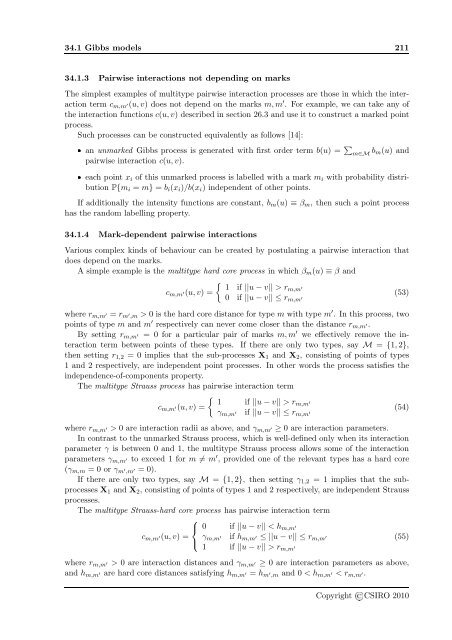Analysing spatial point patterns in R - CSIRO
Analysing spatial point patterns in R - CSIRO
Analysing spatial point patterns in R - CSIRO
Create successful ePaper yourself
Turn your PDF publications into a flip-book with our unique Google optimized e-Paper software.
34.1 Gibbs models 211<br />
34.1.3 Pairwise <strong>in</strong>teractions not depend<strong>in</strong>g on marks<br />
The simplest examples of multitype pairwise <strong>in</strong>teraction processes are those <strong>in</strong> which the <strong>in</strong>teraction<br />
term c m,m ′(u,v) does not depend on the marks m,m ′ . For example, we can take any of<br />
the <strong>in</strong>teraction functions c(u,v) described <strong>in</strong> section 26.3 and use it to construct a marked <strong>po<strong>in</strong>t</strong><br />
process.<br />
Such processes can be constructed equivalently as follows [14]:<br />
an unmarked Gibbs process is generated with first order term b(u) = ∑ m∈M b m(u) and<br />
pairwise <strong>in</strong>teraction c(u,v).<br />
each <strong>po<strong>in</strong>t</strong> x i of this unmarked process is labelled with a mark m i with probability distribution<br />
P{m i = m} = b i (x i )/b(x i ) <strong>in</strong>dependent of other <strong>po<strong>in</strong>t</strong>s.<br />
If additionally the <strong>in</strong>tensity functions are constant, b m (u) ≡ β m , then such a <strong>po<strong>in</strong>t</strong> process<br />
has the random labell<strong>in</strong>g property.<br />
34.1.4 Mark-dependent pairwise <strong>in</strong>teractions<br />
Various complex k<strong>in</strong>ds of behaviour can be created by postulat<strong>in</strong>g a pairwise <strong>in</strong>teraction that<br />
does depend on the marks.<br />
A simple example is the multitype hard core process <strong>in</strong> which β m (u) ≡ β and<br />
{ 1 if ||u − v|| > rm,m ′<br />
c m,m ′(u,v) =<br />
0 if ||u − v|| ≤ r m,m ′<br />
(53)<br />
where r m,m ′ = r m ′ ,m > 0 is the hard core distance for type m with type m ′ . In this process, two<br />
<strong>po<strong>in</strong>t</strong>s of type m and m ′ respectively can never come closer than the distance r m,m ′.<br />
By sett<strong>in</strong>g r m,m ′ = 0 for a particular pair of marks m,m ′ we effectively remove the <strong>in</strong>teraction<br />
term between <strong>po<strong>in</strong>t</strong>s of these types. If there are only two types, say M = {1,2},<br />
then sett<strong>in</strong>g r 1,2 = 0 implies that the sub-processes X 1 and X 2 , consist<strong>in</strong>g of <strong>po<strong>in</strong>t</strong>s of types<br />
1 and 2 respectively, are <strong>in</strong>dependent <strong>po<strong>in</strong>t</strong> processes. In other words the process satisfies the<br />
<strong>in</strong>dependence-of-components property.<br />
The multitype Strauss process has pairwise <strong>in</strong>teraction term<br />
{ 1 if ||u − v|| > rm,m ′<br />
c m,m ′(u,v) =<br />
(54)<br />
γ m,m ′ if ||u − v|| ≤ r m,m ′<br />
where r m,m ′ > 0 are <strong>in</strong>teraction radii as above, and γ m,m ′ ≥ 0 are <strong>in</strong>teraction parameters.<br />
In contrast to the unmarked Strauss process, which is well-def<strong>in</strong>ed only when its <strong>in</strong>teraction<br />
parameter γ is between 0 and 1, the multitype Strauss process allows some of the <strong>in</strong>teraction<br />
parameters γ m,m ′ to exceed 1 for m ≠ m ′ , provided one of the relevant types has a hard core<br />
(γ m,m = 0 or γ m ′ ,m ′ = 0).<br />
If there are only two types, say M = {1,2}, then sett<strong>in</strong>g γ 1,2 = 1 implies that the subprocesses<br />
X 1 and X 2 , consist<strong>in</strong>g of <strong>po<strong>in</strong>t</strong>s of types 1 and 2 respectively, are <strong>in</strong>dependent Strauss<br />
processes.<br />
The multitype Strauss-hard core process has pairwise <strong>in</strong>teraction term<br />
⎧<br />
⎨<br />
c m,m ′(u,v) =<br />
⎩<br />
0 if ||u − v|| < h m,m ′<br />
γ m,m ′ if h m,m ′ ≤ ||u − v|| ≤ r m,m ′<br />
1 if ||u − v|| > r m,m ′<br />
where r m,m ′ > 0 are <strong>in</strong>teraction distances and γ m,m ′ ≥ 0 are <strong>in</strong>teraction parameters as above,<br />
and h m,m ′ are hard core distances satisfy<strong>in</strong>g h m,m ′ = h m ′ ,m and 0 < h m,m ′ < r m,m ′.<br />
(55)<br />
Copyright<strong>CSIRO</strong> 2010












